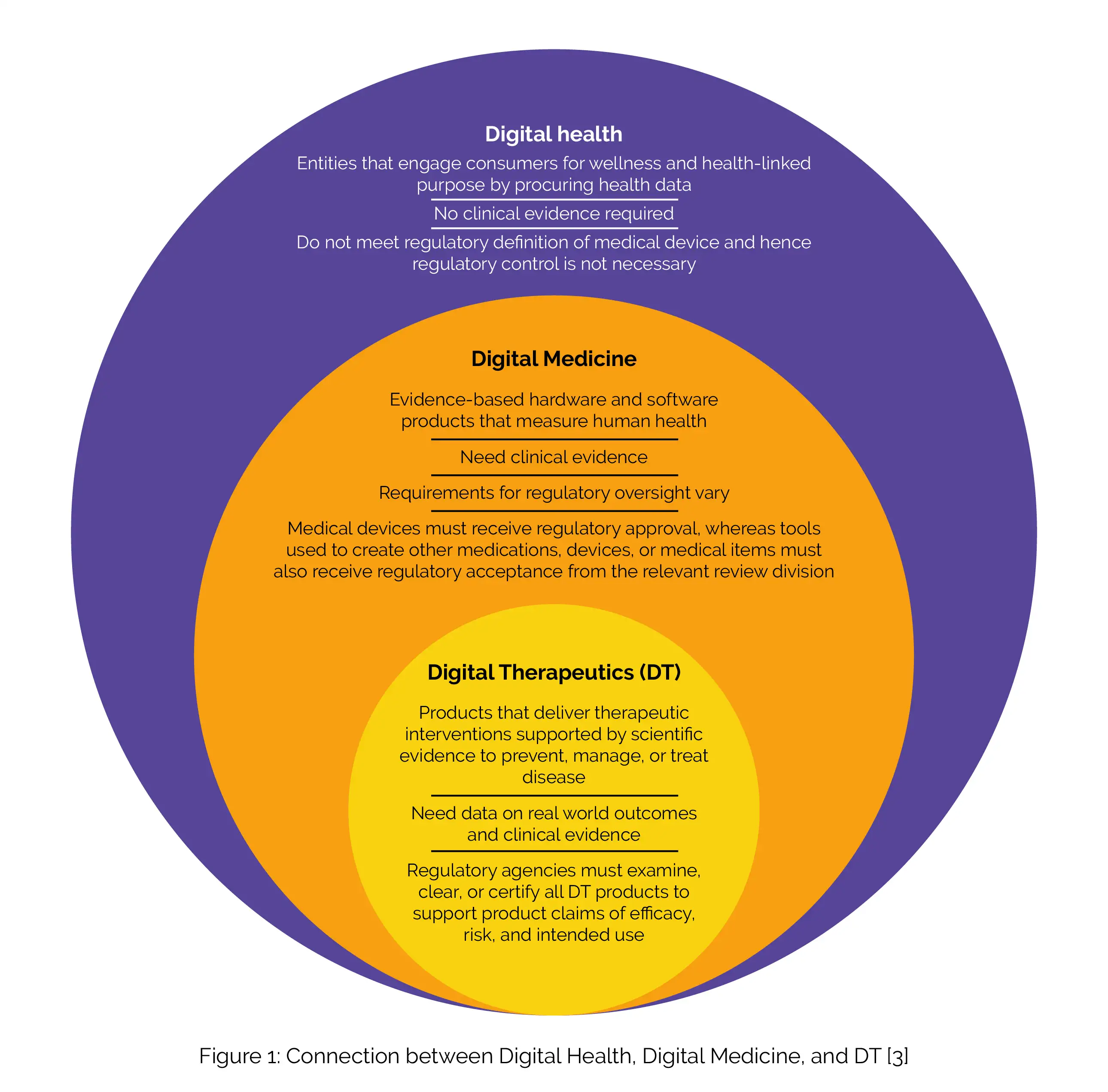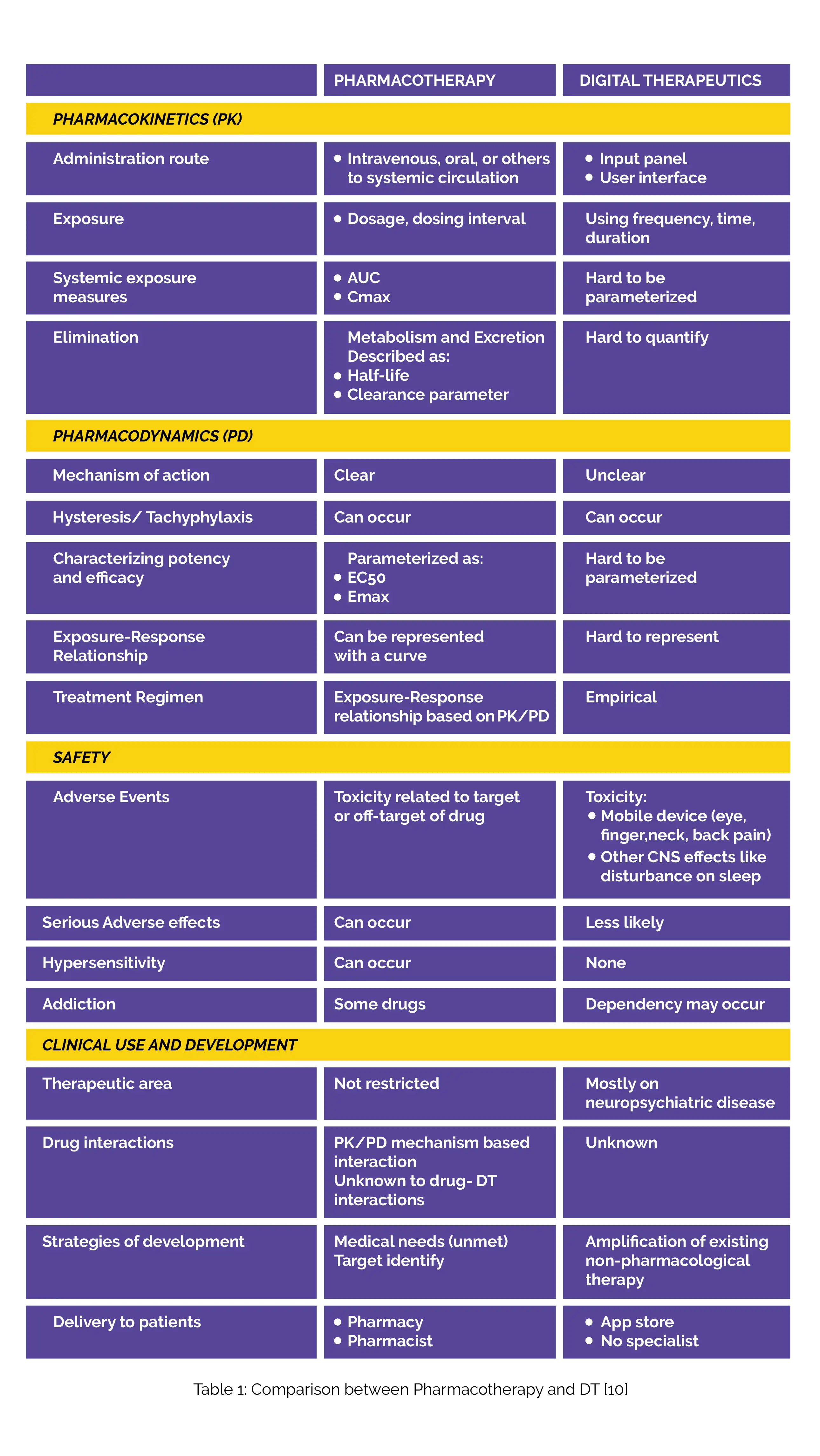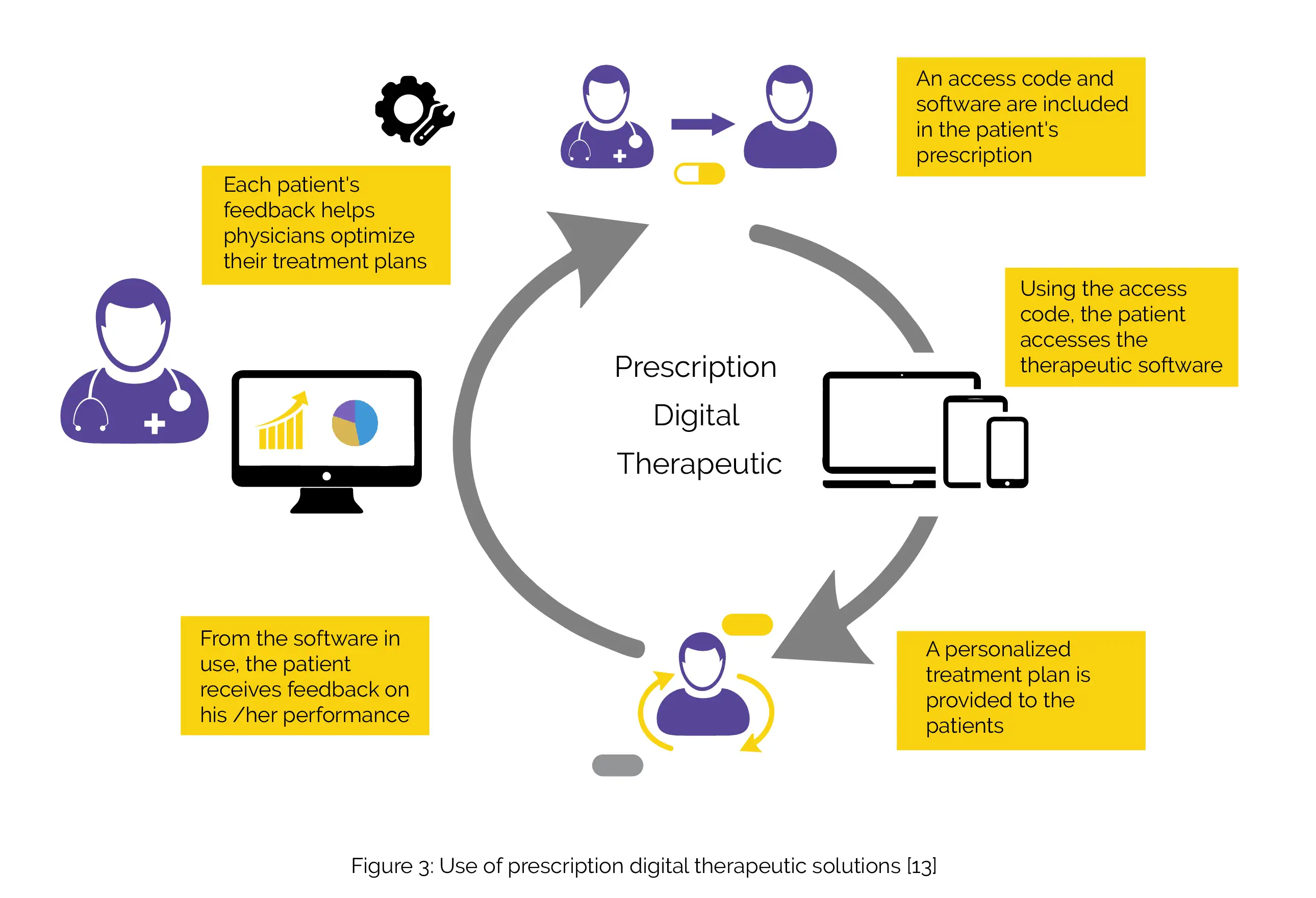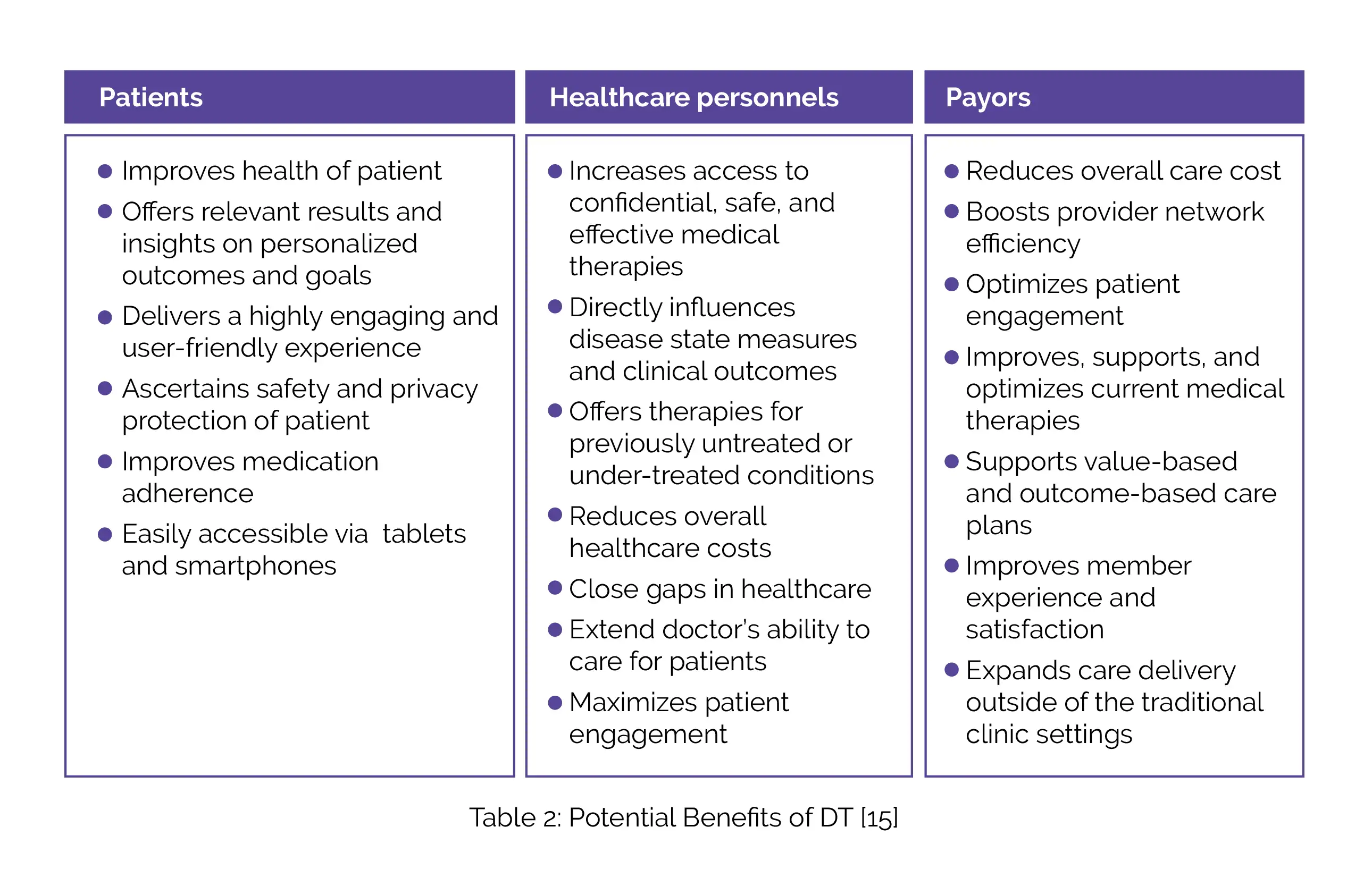Categories
Change Password!
Reset Password!


With digitalization increasing by leaps and bounds, the world of healthcare industry has witnessed tremendous changes over the previous few years. [1] In the past, healthcare was delivered offline (such as pharmacy prescriptions, doctor consultations, mental health counselling services). [2] With medical care becoming digital, patients today are highly empowered. Digital health includes a wide array of platforms that apply technological solutions to improve medical care facilities. One such important category of digital health solutions is Digital Therapeutics or Digital Therapy (DT). [3]
The recent emergence of DT has assisted in the online delivery of healthcare services. [2] It has brought digital health products to the level of medicines rather than just apps, making digital health products more sophisticated than ever before. [4] DT, a booming field, is defined as a regulatory-approved digital system or application that is prescribed for the treatment of health conditions, comparable to that of novel drug molecules or medical devices. [2, 5]
DT first became popular in 2013 when online coaching software was designed for prediabetics to evade getting sick by exercising more and losing weight. [6] From the emergence of smart medical equipments and software applications to cloud-based data platforms and electronic health records - all of this has made it possible to improve the treatment of patients. [1] DT represents an innovative area of therapy and has found novel means to harness the unique power of emerging technologies to boost healthcare outcomes. [7, 8]
DT technologies signify a critical shift in the way physicians and patients interact with each other. [5]
Advancements in artificial intelligence coupled with the increasing importance of mobile technology in day-to-day life have broadened DT application to the healthcare sector. [9] For promoting DT adoption, educating medical care providers about digital therapy is essential to ensure adequate prescribing. It is equally important to ensure patient affordability, which is determined largely by government and insurance reimbursements in many countries. [2]
Association between Digital Health, Digital Medicine, and Digital Therapeutics
The term "digital health" serves as an umbrella entity related to digital medicine, which includes DT. All of these product categories express varying amounts of hazards and claims. Furthermore, they have differing standards for regulatory monitoring and clinical evidence. The broad area of digital health includes technology, platforms, and systems that interact with customers for wellness, lifestyle, and health-associated goals. To support clinical operations, digital health organizations can collect, store, and transfer health data. Digital health systems include, among other things, tools for managing clinical treatment, telehealth systems, systems that employ consumer health information, and health information technologies.
On the other side, digital medicine comprises hardware or software devices that measure or intervene in the service of human health and are often backed by evidence. Examples include tools for remote patient monitoring, digital biomarkers, and digital diagnostics. As previously stated, DT includes evidence-based treatment strategies for the management, prevention, or treatment of a medical issue. Wearable devices, digital sensors, specific virtual reality applications, and artificial intelligence gadgets are a few examples of DT uses (Figure 1).

Digital Therapeutics versus Pharmaceutical Drugs: What's the difference?
Unlike pharmaceutical drugs which involve the administration of a substance into the body, DT is dependent on external factors like a reliable internet connection, a complementing cellular device, and skilled user engagement. In truth, DT is designed to benefit only those who are able to operate and afford technological hardware, making them potentially biased towards patients. [2] A fundamental difference between DT and pharmaceutical drugs is that the therapeutic effects of DT arise without any active substance in the systemic circulation. An analysis of the concept of pharmacotherapy compared to DT from the clinical pharmacology perspective is shown in Table 1.

Since digital interventions need the requisite user ability and hardware to function, socioeconomic considerations (such as level of education, family income) and age must be taken into consideration. Therefore, baseline features may likely need to be modified more strongly for socioeconomic considerations when DT is indirectly compared to pharmacologic therapies for health technology assessment purposes.
DT mainly relies on a person's behavior and attitude towards health, as opposed to pharmaceuticals that influence the biological mechanism (such as Sodium-glucose Cotransporter-2 [SGLT2] inhibitors for diabetes or antiplatelets to avoid cardiovascular complications). Technology literacy, age, and other socioeconomic factors (like income, nationality) may potentially play a larger role when conducting reimbursement decisions in DT compared to pharmaceutical drugs, where consideration for human biological factors (like genetics, ancestry) is necessary to determine promising therapeutic efficacy. [2]
How Does Digital Therapeutics work?
With the expeditious adoption of innovative technologies, the healthcare sector is reshaping and transforming itself in better ways. [11] The potential to employ DT along with therapeutic agents to boost healthcare outcomes has aroused the interest of big pharmaceutical industries to enter the DT field via investments and strategic alliances with tech companies. In comparison to traditional pharmacological interventions alone, this exciting development will give patients the chance to become more aware of their health and capable of managing their disease in an active manner. This, in turn, would minimize the burden on medical care systems. [12]
A DT strategy blends digital diagnostic accuracy with human touch of care delivery. With DT, the clinical data acquired by phones or tablets may be quickly communicated to physicians via wireless headphones and into healthcare networks. This leads to better outcomes and improved care for individuals with diverse illnesses. Patients are not even required to go to hospitals. [5]
DT, a novel class of apps, aids in the treatment of illnesses through remote surveillance. [3] These therapies aim to involve patients in individualized treatment or disease prevention programs by facilitating behavioral or psychological changes, offering support for motivation, and instilling healthy lifestyle alterations. [13] DT apps are designed to generate positive long-term outcomes; for example, they can urge patients to stick to a certain diet and exercise program, as well as medication regimens. [3] Three business models are intertwined in DT: Biopharmaceutical, Direct-to-consumer, and Technology (Figure 2).

The resulting data and analytics provide invaluable insights for the improvement of commercial, clinical, and patient outcomes. [14] DT products empower payers, patients, and medical care workers with intelligent and accessible tools to address a broad spectrum of conditions via data-driven interventions. Despite the fact that DT is a fundamental part of digital health domain, it is distinct from telehealth, diagnostics, and various digital health products. [15] DT applications are designed to address target-specific pathological conditions, most notably severe chronic diseases like diabetes, pulmonary disorders, neurological deficits, and cardiovascular disorders. Figure 3 summarizes how prescription digital therapeutic solutions are used.

Why Now?
The COVID-19 pandemic has indeed brought DT to the forefront of medicine. [16] DT solutions have become the need of the hour to sustain with the rising number of empowered people making their own therapeutic decisions. [3] The COVID-19 crisis elicited a rise in the need for remote patient monitoring and treatment (majorly due to the fact that people cannot physically meet their medical care providers due to COVID-19 restraining orders). In such cases, DT solutions are valuable to conveniently track and monitor patients' progress while delivering the necessary measures remotely. [13]
Following COVID-19, consumers are not only prepared to embrace DT as a beneficial therapeutic option for a variety of illnesses, but they are also beginning to demand it. Digital medication, like their favourite consumer app or game, has now become a source of comfort and solace, putting individuals in charge of their treatment at a time when there are so many unknowns surrounding their health. [16]
The accelerating reduction in computation expenses, increasing investment required to build up a molecule-based drug, improved access to healthcare data, and a significant drop in sensor technology fees have aided the delivery of high-quality, clinically verified therapies at a remarkable scale. Technological developments and a changing legislative environment will almost certainly result in an increase in digital health treatments targeting a broader spectrum of health issues. [17]
Benefits of Digital Therapeutics in Today’s World
DT exhibits a remarkable potential to boost productivity, quality, efficiency, and accessibility of health care provision and also offers a wide array of other health benefits. In terms of cost-effectiveness, innovative therapeutic methods, and data collection, DT has brought a revolution in the current medical field. [6,18] The most pivotal benefits of DT encompass direct patient access, lower treatment costs, encouragement of healthy lifestyle changes, and the ability to replace or supplement traditional treatments. [6] By utilizing scientifically designed technology that monitors all elements of therapy progression as well as changes in patient behavior, DT enables enhanced and long-term health results.
These technological applications help motivate patients to stick to approved treatment plans, diets, and exercise routines. The software utilized in DT solutions must be equipped with accurate and relevant evidence and be capable of illness prevention and management. [19] DT also make it possible for patients, payors, and providers to collaborate more frequently to develop ground-breaking approaches to improve patient care. [20] There are several ways in which DT can benefit patients, healthcare professionals, and payors, as illustrated in Table 2. [19]

An extensive range of mental health disorders has been successfully addressed with DT. For instance, DT uses artificial intelligence to offer individualized medications and digital diagnostics for pediatric mental healthcare. With the regular surveillance of behavior, diseases like Alzheimer’s disease, Parkinson’s Disease, depression, dementia, insomnia, anxiety, and hypertension can be effectively controlled through DT. [11] For controlling preoperative anxiety and postoperative pain, virtual reality-based DT solutions are being utilized to build a virtual environment to aid patients remain relaxed and calm. According to a recent study, when patients wore virtual reality headsets before surgery, 80% reported less pain, and 73% said they felt less worried. [21]
With the recent US-FDA sanction of the first game-based DT used for the treatment of attention deficit hyperactivity disorder, the scope of DT has expanded beyond patient monitoring. [2] Evidence that DT is beneficial in the management of substance abuse is also developing. Recently, US-FDA officially authorized a mobile application to treat marijuana, alcohol, and cocaine addiction, citing clinical study data that demonstrated abstinence in 40% of patients using a DT application for 3 months, compared to 17.6% of those using conventional therapy alone. Furthermore, by minimizing the demands on physicians' time, DT may also provide cost-effective therapies as compared to traditional therapy. [3]
Future of Digital Therapeutics
Digitalization is envisioned to have a substantial impact on healthcare. [7] The DT market is anticipated to escalate tenfold in the next three to five years, with a projected market value of $9 billion (USD) by the year 2025. [12] It will likely influence all aspects of the delivery of health care, encompassing health promotion, disease prevention, primary care, self-care, specialized care, social care, and long-term care. [7]
The introduction of DT is altering the scenario for novel drugs, product reimbursement, and regulatory supervision. As an outcome, new data-sharing mechanisms and pricing models will be developed in the near future to integrate these items into wider treatment regimens and regulatory structures for medication and device approvals. [3] The digitization of healthcare has the potential to alter the way health systems are organized and financed, the sort of health professionals required, the role of those professionals and patients, as well as the health services supplied. [7]
Terabytes of potentially important medical data may be generated by DT, which can yield strong tools for clinical research. DT, when applied wisely, has the potential to revolutionize medication development by enhancing clinical procedures, data quality, endpoints, and therapeutic outcomes. [22] DT's successful implementation will assist to decrease cardiovascular diseases and cancer by at least 20% and may elicit a complete cessation of these diseases in developed countries. [5]
Conclusion
DT solutions to tackle chronic and other difficult‑to‑treat conditions will undoubtedly shape the future of medical care delivery. [3, 8] They offer evidence-based, software-driven therapeutic interventions to prevent and treat a medical disease. A growing number of drug companies are approaching DT with a contemplative approach. To get authentic information on the efficacy and safety of DT, further rigorous testing through randomized trials is necessary. Health authorities, like the US-FDA and the National Health Service, are also recognizing the potential of DT and supporting research. [3]
Technology may never completely substitute some aspects of healthcare. Thus, it's conceivable that DT will supplement current therapies to yield better results for patients. As DT advances, novel health technology assessment tactics will be required to evaluate these interventions. [2] The bottom line is that the demand for DT is skyrocketing. Given the current scenario, it is reasonable to anticipate that a substantial portion of the medical care budget is going towards creating and disseminating digital health solutions, including DT and monitoring technologies. The need for such solutions may therefore be expected to magnify in the near future. [13]
It is the responsibility of DT developers to make sure that their creations are moral, secure, and effective. [4] With SARS-CoV-2 and Omicron already fueling the requirement for remote patient engagement and mental well-being, DT solutions, with their promising ability to offer evidence-based personalized care, can play a pivotal role in addressing the rising shortage of medical personnels and in effective management of chronic illness. [21]
References
1. Digital Therapeutics: How Software Can Treat Diseases. Available from:
https://www.altexsoft.com/blog/digital-therapeutics/ [Last Accessed on: 28 September 2022]
2. Yan K, Balijepalli C, Druyts E. The impact of digital therapeutics on current health technology assessment frameworks. Frontiers in Digital Health. 2021:59.
3. Dang A, Arora D, Rane P. Role of digital therapeutics and the changing future of healthcare. Journal of Family Medicine and Primary Care. 2020 May;9(5):2207.
4. Rassi-Cruz M, Valente F, Caniza MV. Digital therapeutics and the need for regulation: how to develop products that are innovative, patient-centric and safe. Diabetology & Metabolic Syndrome. 2022 Dec;14(1):1-7.
5. Future of Digital Therapeutics Industry in India. Available from: https://opportunityindia.franchiseindia.com/article/future-of-digital-therapeutics-industry-in-india-14284 [Last Accessed on: 28 September 2022]
6. Khirasaria R, Singh V, Batta A. Exploring digital therapeutics: The next paradigm of modern health-care industry. Perspectives in Clinical Research. 2020 Apr;11(2):54-8.
7. Recchia G, Capuano DM, Mistri N, Verna R. Digital Therapeutics-What they are, what they will be. Acta Sci Med Sci. 2020;4:1-9.
8. How Can We Speed Up Adoption Of Digital Therapeutics? Available from: https://www.meddeviceonline.com/doc/how-can-we-speed-up-adoption-of-digital-therapeutics-0001 [Last Accessed on: 28 September 2022]
9. Ellis TD, Earhart GM. Digital Therapeutics in Parkinson's Disease: Practical Applications and Future Potential. J Parkinsons Dis. 2021;11(s1):S95-S101.
10. Chung JY. Digital therapeutics and clinical pharmacology. Translational and Clinical Pharmacology. 2019 Mar 1;27(1):6-11.
11. Will Digital Therapeutics Solution Reshape The Healthcare Industry? Available from: https://mobisoftinfotech.com/resources/blog/digital-therapeutics-solutions-reshaping-the-healthcare-industry/ [Last Accessed on: 28 September 2022]
12. Digital Therapeutics: Past Trends and Future Prospects. Available from: https://www.evidera.com/digital-therapeutics-past-trends-and-future-prospects/ [Last Accessed on: 28 September 2022]
13. Digital Therapeutics: Key Concepts and Regulations to Tackle COVID-19 Pandemic. Available from: https://www.rootsanalysis.com/blog/digital-therapeutics-key-concepts-and-regulations-to-tackle-covid-19-pandemic/ [Last Accessed on: 28 September 2022]
14. Digital Therapeutics and the Future of Pharma. Available from: https://torreya.com/publications/digital-therapeutics-and-future-of-pharma_torreya-feb2020.pdf [Last Accessed on: 28 September 2022]
15. Digital Therapeutics - Reshaping the future of medicine. Available from: https://capra.ca/en/blog/digital-therapeutics-reshaping-the-future-of-medicine-2022-05-13 [Last Accessed on: 28 September 2022]
16. Covid-19 is bringing digital therapeutics to the forefront of medicine. Available from: https://www.akiliinteractive.com/console-blog/2021/12/1/covid-19-is-bringing-digital-therapeutics-to-the-forefront-of-medicine [Last Accessed on: 28 September 2022]
17. How digital therapy benefits patients, providers, and the health ecosystem. Available from: https://www.ibm.com/downloads/cas/DO1REYRX [Last Accessed on: 28 September 2022]
18. Kario K, Harada N, Okura A. Digital Therapeutics in Hypertension: Evidence and Perspectives. Hypertension. 2022 Oct;79(10):2148-2158.
19. What are Digital Therapeutics? Available from: https://www.news-medical.net/health/What-are-Digital-Therapeutics.aspx [Last Accessed on: 28 September 2022]
20. Catching the Next Wave Advancing Health Care: Digital Therapeutics. Available from: https://commed.umassmed.edu/blog/2021/04/20/catching-next-wave-advancing-health-care-digital-therapeutics [Last Accessed on: 28 September 2022]
21. Digital Therapeutics: Enterprise Opportunities in Virtual Healthcare. Available from: https://www.tcs.com/content/dam/tcs/pdf/Industries/life-sciences-and-healthcare/insights/healthcare-digital-therapeutics0.pdf [Last Accessed on: 29 September 2022]
22. Sverdlov O, Van Dam J, Hannesdottir K, Thornton‐Wells T. Digital therapeutics: an integral component of digital innovation in drug development. Clinical Pharmacology & Therapeutics. 2018 Jul;104(1):72-80.
Comments (0)